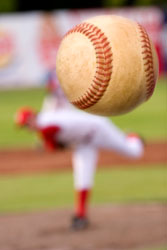 NEW YORK—Perhaps in no sports competition is great eyesight more important than it is in baseball. Indeed, superior vision is generally acknowledged to be a prerequisite for attaining the highest levels of competition in the sport.
NEW YORK—Perhaps in no sports competition is great eyesight more important than it is in baseball. Indeed, superior vision is generally acknowledged to be a prerequisite for attaining the highest levels of competition in the sport.
The ability to quickly identify the rotation of the baseball—and thus the type of pitch that’s been thrown—by honing in on the spinning 108 red stiches that knit the two pieces of cowhide cover together is key to becoming a truly great hitter.
This rare ability to focus and see clearly the movement of a 90 to 100 mph baseball pitch is on the national stage right now as the final four Major League teams play to determine which two ball clubs will advance to the pinnacle event of the sport, the World Series.
This year’s World Series—a best-of-seven competition between the winner of the National and American League pennants—is scheduled to begin Tuesday, Oct. 24. And regardless of whether you’re a Yankees, Cubs, Astros or Dodgers fan, there are few, if any, baseball “people” who don’t watch the games with sincere admiration of the extraordinary talent—and eyesight—that today’s Major League ballplayers demonstrate on a regular basis.
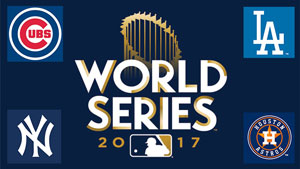 “It may surprise you, but 20/20 is not even close to the vision necessary to play major league baseball,” according to a blog post on the Advanced Vision Therapy Center website. “Below-average vision can be enough to ruin the aspirations of an otherwise talented athlete and end a potential career before it begins.”
“It may surprise you, but 20/20 is not even close to the vision necessary to play major league baseball,” according to a blog post on the Advanced Vision Therapy Center website. “Below-average vision can be enough to ruin the aspirations of an otherwise talented athlete and end a potential career before it begins.”
Often, the consensus among the general population is that 20/20 vision is considered “perfect” vision.
However, according to Boise, Idaho-based Advanced Vision, the average baseball player in the major leagues has vision of 20/12 and “3.9 percent of players have 20/8 eyesight—which is the limit of human vision.”
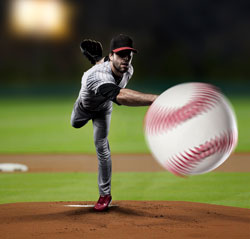 In his book, “The Sports Gene,” author David Epstein writes that baseball players overall have remarkable eyesight. He noted that the ophthalmologist Louis Rosenbaum tested almost 400 high-level baseball players over a four-year period and found that their average visual acuity was about 20/13. What this means, he said, is that the typical professional baseball player can see at 20 feet what others only see at 13 feet.
In his book, “The Sports Gene,” author David Epstein writes that baseball players overall have remarkable eyesight. He noted that the ophthalmologist Louis Rosenbaum tested almost 400 high-level baseball players over a four-year period and found that their average visual acuity was about 20/13. What this means, he said, is that the typical professional baseball player can see at 20 feet what others only see at 13 feet.
“The ability to consistently hit a baseball thrown at speeds approaching 100 miles an hour, with a baffling array of spins and curves, requires the kind of eyesight commonly found in only a tiny fraction of the general population,” Malcolm Gladwell wrote in his review of Epstein’s book in The New Yorker magazine.
Ted Williams, the legendary left-handed hitter for the Boston Red Sox in the 1940s and 1950s, was known for his perfect swing and 20/10 eyesight. He would not swing at bad balls and therefore was often walked by pitchers.
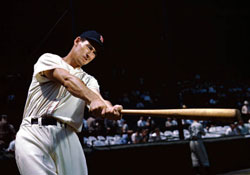 Ted Williams
Ted WilliamsAnother renowned hitter in baseball, Barry Bonds, also was considered to have superior vision (although many believe Bonds’ baseball success also was a result of other factors). According to a report by Collegiate Baseball News in 2014, Bonds’ vision was tested by Dr. Bill Harrison, a leading visual performance specialist, who found that none of the players he tested over decades of research had vision that compared with Bonds’ eyesight.
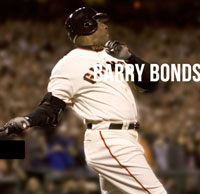 “I have a battery of tests which I have performed on Major League players going back to the early 1970s for a number of organizations,” Harrison told Baseball News. “In testing thousands of Major League hitters, Barry Bonds tested out with the highest vision readings of any baseball player we had ever worked with.”
“I have a battery of tests which I have performed on Major League players going back to the early 1970s for a number of organizations,” Harrison told Baseball News. “In testing thousands of Major League hitters, Barry Bonds tested out with the highest vision readings of any baseball player we had ever worked with.”
According to Key Whitman Eye Center’s Amanda Hoelscher, OD, “Eighty-one percent of major league baseball players have visual acuity of 20/15 or better. So they can resolve the image of that pitch much better than most of the population,” she wrote, noting also that professional baseball players also have better reaction time than the average person or baseball fan. (Key Whitman is a fully integrated ophthalmology practice in the Dallas-Fort Worth metroplex.)
It is certainly no secret that eyesight is one of the keys to success in baseball. There are now eyecare experts who work with baseball players to identify any weaknesses in their vision and work to help them correct these deficiencies.
According to Advanced Vision Therapy, there is a battery of specific eye tests that a trained optometrist can use to evaluate and assess a person’s vision specifically for baseball. These tests are:
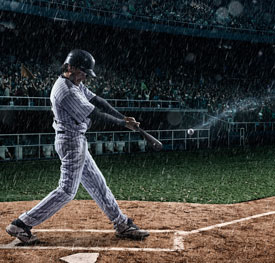
- Visual Acuity Testing: Tests visual acuity down to the physiological threshold of 20/8. Eye charts used by most eye doctors can only test to 20/15, with no way to test beyond a visual acuity of 20/15.
- Depth Perception/Contour Stereo Testing: Tests the dimensional capabilities of the athlete's vision, a critical component of baseball.
- Letter Contrast Sensitivity Testing: Contrast sensitivity has been found to be a significant differentiator in a player's performance. Whereas visual acuity measures the quantitative aspect of vision, contrast testing measures the qualitative aspect of vision.
- Developmental Eye Movement: This test helps identify a differential diagnosis between cognitive function and any eye movement abnormalities.
- Eye Alignment: The eye alignment test measures the tendency of the athlete's vision to turn in or out, up or down.
- Fusional Ability: This test measures how well the eyes are working together.
With all of the advances in technology and training procedures that have changed so many aspects of day-to-day life, even baseball has to rethink some of its time-worn concepts. So much that the baseball adage “See the ball, hit the ball,” has been weighted today with a much more complex understanding of just how players really do “see” the ball.